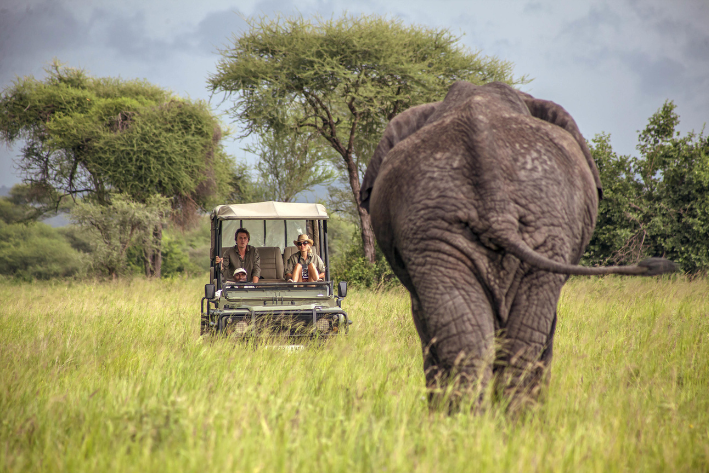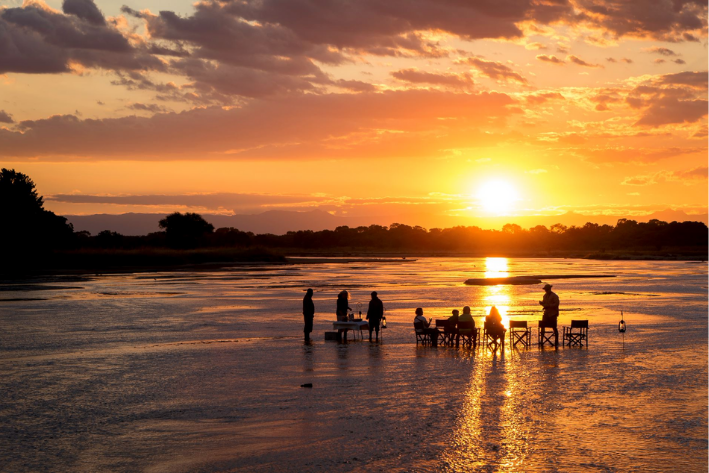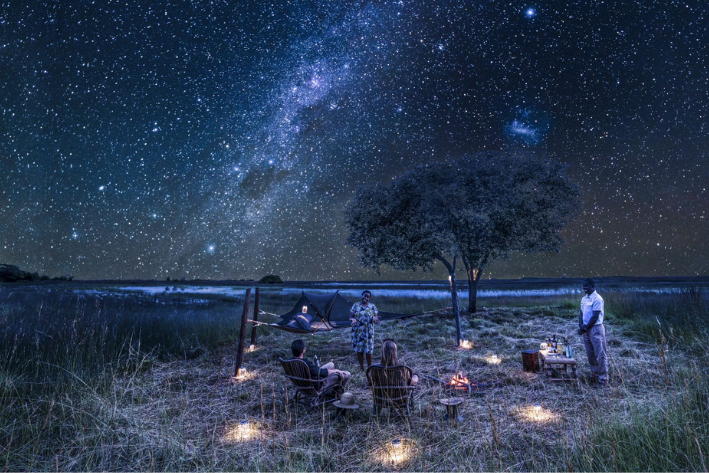My Safari to Tanzania
A safari to Tanzania really does offer everything!
When it comes to safari experiences, a safari to Tanzania really delivers on all aspects from walking safaris, helicopter safaris, cultural experiences, sleep-outs, incredible guides, a wide range of safari camps and lodges, masses of wildlife and some of the best beaches in Africa……….So when are you coming?
I was lucky enough to be invited on a safari to Tanzania by the team from Legendary Expeditions who have luxury camps and lodges in Tanzania. It had been a while since I was in Tanzania and so jumped at the opportunity to return. This was going to a safari like no other, although some aspects of the safari were only revealed to us once we were there. This kept us on the edge of our seats in anticipation of what was to come. I flew from Cape Town to Johannesburg and connected with a flight to Addis Ababa and onwards to Kilimanjaro in Arusha. It was a long journey to get here, but we were welcomed with happy smiles by the team from Legendary Lodge. The process of getting through Immigration in Kilimanjaro, was a bit slow, but they are working on that and will perfect it in no time.
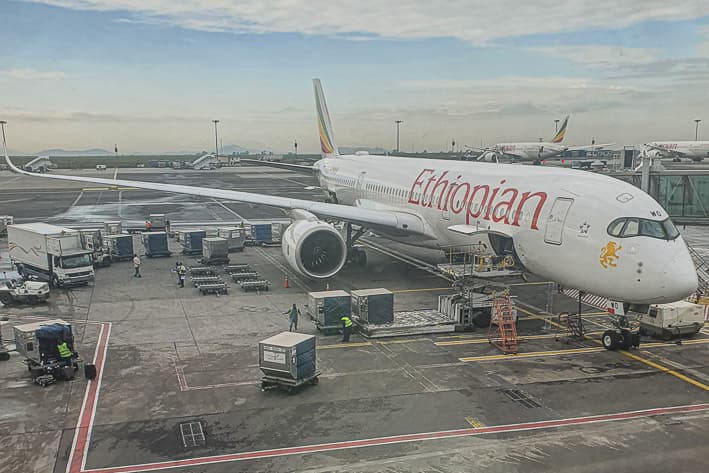
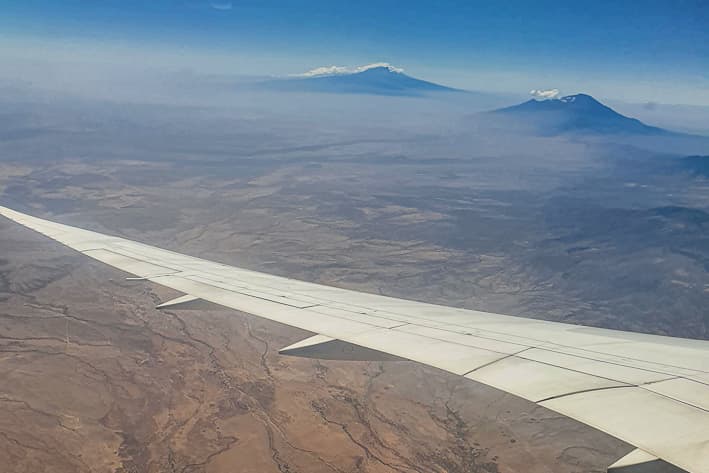
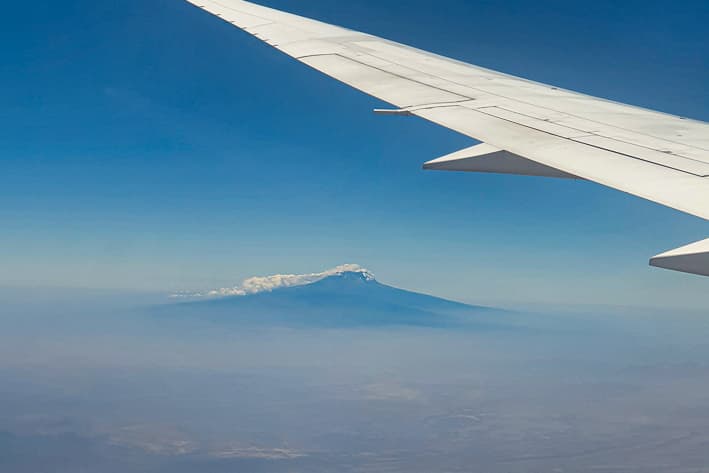
Let the Safari begin…..
After getting off the plane, guests hand in their health form before proceeding to have a rapid Covid Test done. Once the results are out, after about 15 minutes, you proceed to immigration, collect your luggage and go through customs. Everyone flying into Tanzania has to complete an online health form which generates a Q-Code, and this is what is checked at the first desk after disembarking off the plane. This online form needs to be completed within 24 hours of arriving in Tanzania (https://afyamsafiri.moh.go.tz/#/home). After completing the form, there is the option to pay for your Rapid Covid Test online, which is advisable to avoid standing in more queues on arrival in Kilimanjaro Airport.
The transfer from Kilimanjaro Airport to Legendary Lodge took about 45-minutes through Arusha town, but as soon as we arrived at Legendary Lodge, it felt like we had arrived at an oasis. Located on a coffee plantation and amongst trees and gardens, this is the perfect place to relax after your long flight and before heading off on safari. The team at Legendary Lodge are very attentive and friendly and they took very good care of us, feeding us well and making sure we were well hydrated 😊. That afternoon we had a chance to explore the grounds on the lodge’s mountain bikes. What a great way to ease into our safari to Tanzania.
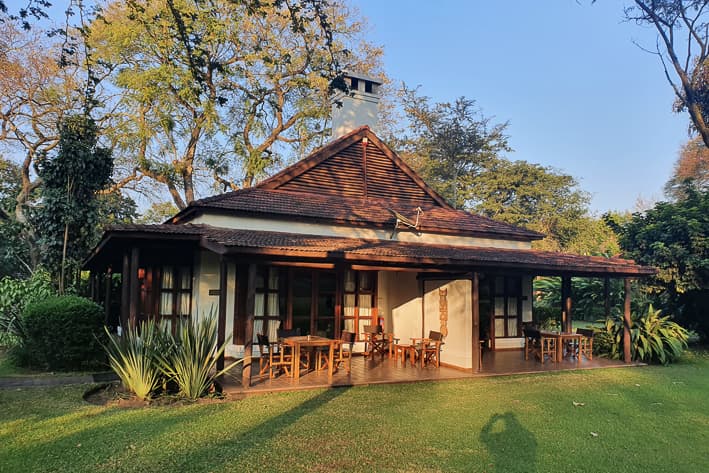
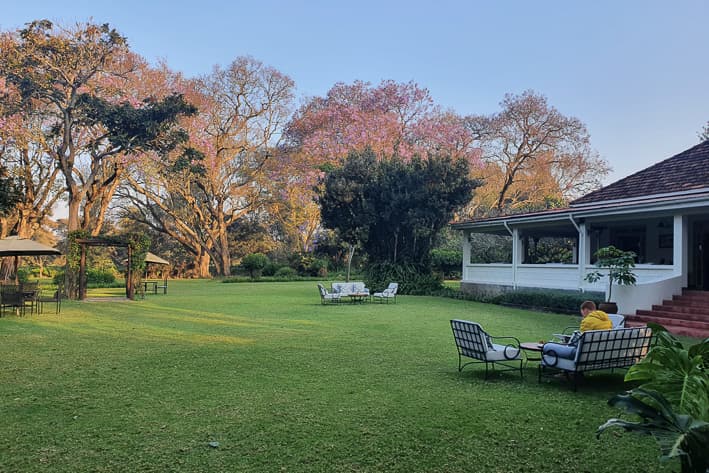
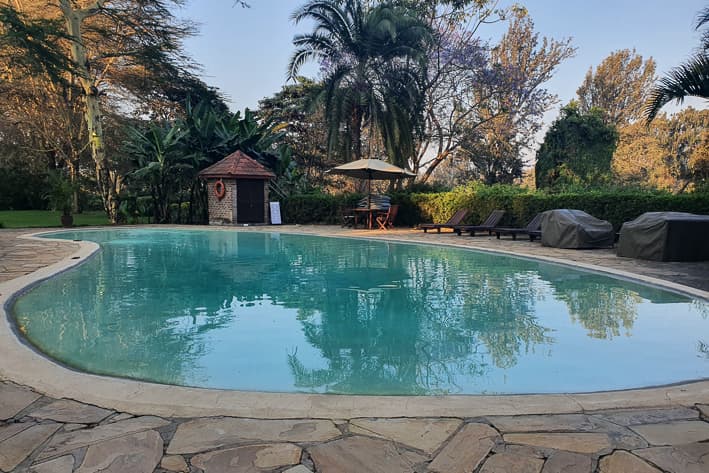
Chem Chem and the “Slow Safari”……
The following morning after an amazing breakfast, we set off by road to Chem Chem Lodge for the start of our Tanzania Safari. Located on the shores of Lake Manyara, Chem Chem Lodge is a luxury lodge that has perfected the “slow safari”. Guests staying here are reminded what it means to be in Africa and teaches us all to look around and enjoy the area we are in as opposed to rushing around ticking boxes, but not actually appreciating where you are. Every group staying at Chem Chem Lodge gets their own guide and vehicle and so can tailor their activities around their own schedule. We enjoyed an afternoon walk with our guide and Maasai warrior to the shores of Lake Manyara which ended with a lovely sundowner overlooking the Great Rift Escarpment and lake. The following morning, we set off before sunrise to climb a small hill that offers incredible views over the concession, Lake Manyara and Lake Burungi and the surrounding villages. This was an energetic way to start the day but was incredible to see what the team at Chem Chem are doing in terms of creating a wildlife corridor between the farms and villages. Over the years the team at Chem Chem have seen wildlife returning in great numbers, knowing they are protected. This is one of the reasons we love sending guests to Chem Chem and is one of the core conditions when choosing who we partner with.
Chem Chem Lodge is a beautiful, tented lodge in a stunning location and because of their concept of the “slow safari” is the perfect start or end to your Tanzania safari as it is not about driving around looking for animals but is more about appreciating where you are.
After our morning hike, we were surprised by a bush breakfast under the branches of an enormous baobab tree. What a way to end the morning. After breakfast we headed to a local Maasai Boma where we met the chief of the village who proudly showed us around his compound, introducing us to some of his wives and children. We were invited into one of his huts where he explained to us more about his culture and way of life and how things have changed over the years. This was by no means a “tourist” show put on for us but was an authentic cultural experience where we learnt a lot about the Maasai culture. After learning about his life, we continued to Little Chem Chem which is a beautiful tented camp overlooking Lake Burungi near Tarangire National Park. We were treated to a tasty lunch under the trees overlooking the waterhole and were even visited by a small herd of elephants. Out of the three lodges on the Chem Chem Concession, this was my favorite. It was small, intimate and authentic with incredible views of the open plains, waterhole and lake. The food and service all were top notch, and you can see that the personal touches have all been thought of with the guest in mind.
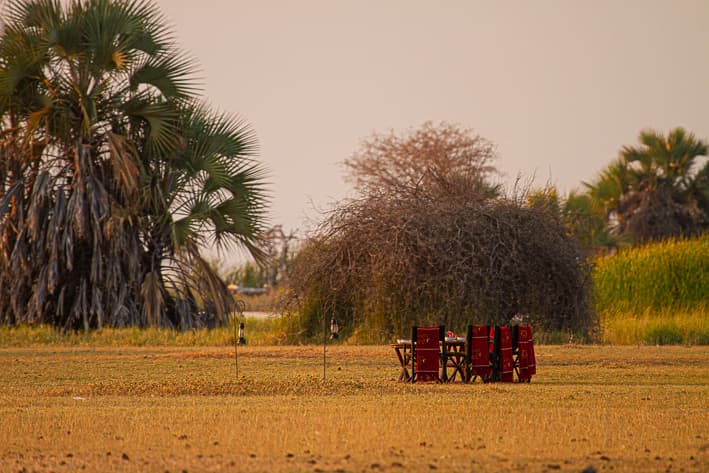
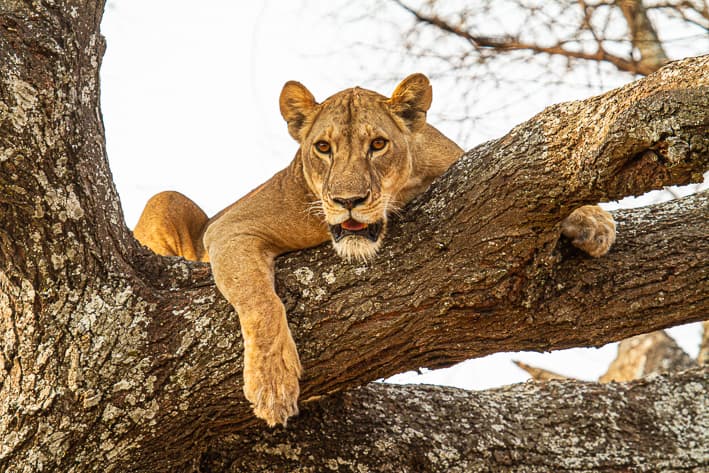
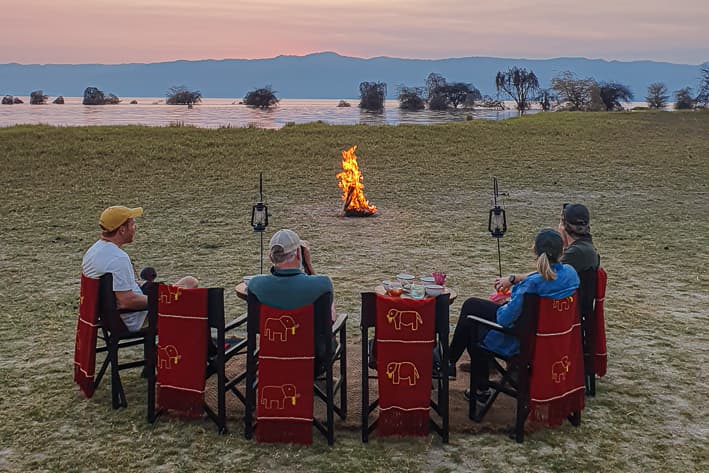
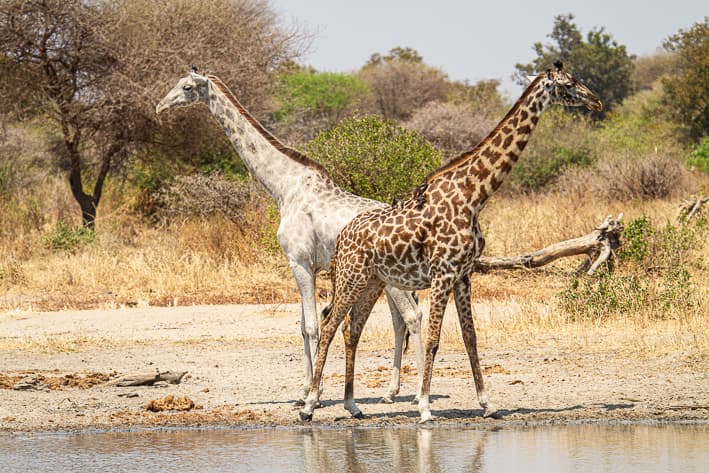
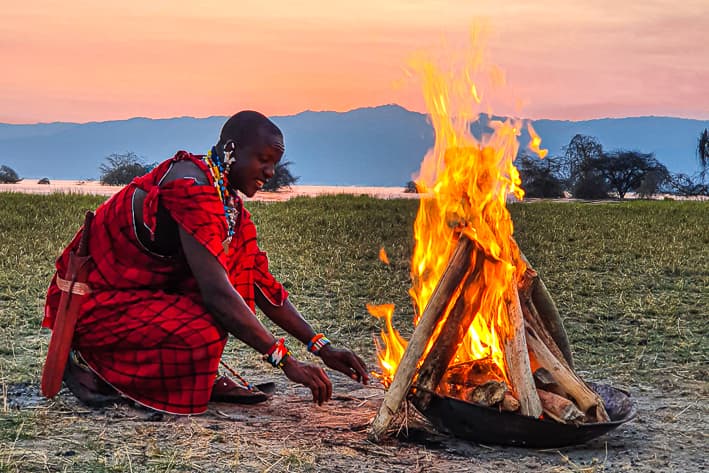
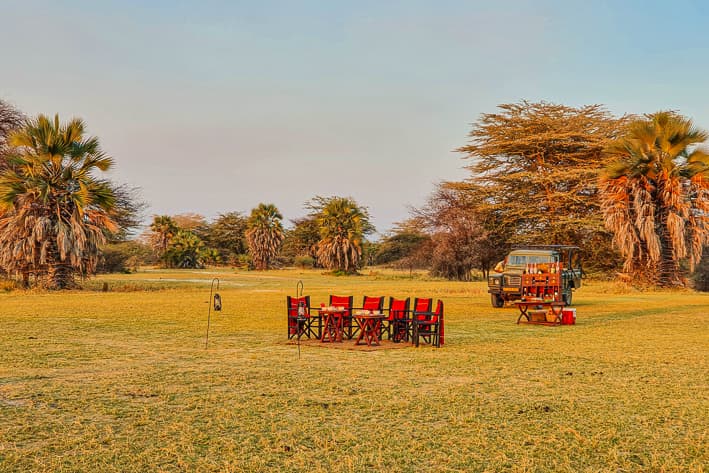
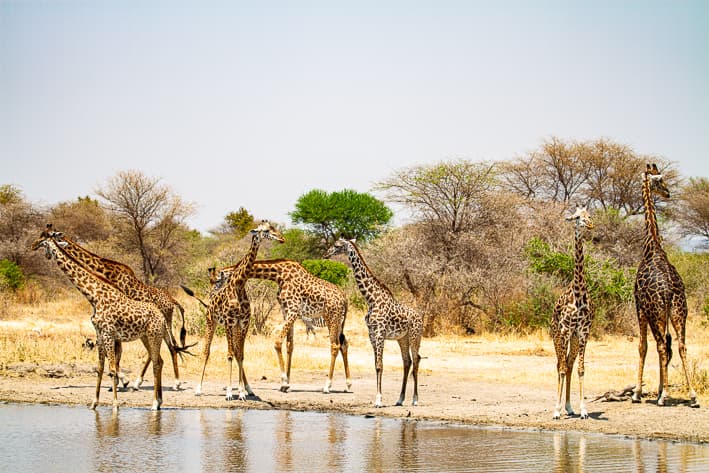
Authentic Cultural experiences…..
That afternoon we had another authentic and real cultural experience, this time meeting with the women from the Barbaig tribe. Again, there was no “show” of dancing and singing for the tourists, this was a real experience where they were proud to show us around their homestead and explain to us how they live.
After yet another great cultural experience, we headed to Forest Chem Chem where we were spending the night. On the way to the lodge, we came across a waterhole that was abuzz with activity. We spent at least 1.5 hours sitting at the waterhole watching herds of elephants, large tuskers, giraffe (including an albino giraffe called Omo), waterbuck, zebra, wildebeest, buffalo, impala and plenty birds. This was by far the most giraffe I have ever seen in one place. As we arrived at Forest Chem Chem, which is a private use safari camp, we were whipped off for another surprise dinner. Located not far from the camp and under a huge baobab tree was our dinner table. Lights lit up the tree, there were fires going and there was an old Land Rover that had been converted into a bar – everything had been thought of. This is again, one of the things we look for when looking at who to partner with, and that is the focus of camps on guest experiences and Chem Chem has certainly ticked that box. Every meal was in a different location, service was world class, food was exceptional, and the staff were friendly and attentive, we could not have asked for anything more.
The following morning, we were up bright and early for our final game drive before heading to our next location. On the drive, our guide Salum saw fresh lion tracks in the road and so began our mission of tracking the pride. This is where guides can really prove themselves as they use their expert knowledge of animal behavior, and also their expert knowledge of the area in which they are operating and Salum certainly proved himself here. After following the tracks for several minutes, he made a decision to go in the direction he thought the pride had gone and within a few minutes he pointed into a tree and there was a lioness and 2 cubs relaxing in the branches. This is quite a unique thing as lions usually don’t climb trees, but there are a few places in Africa where this is quite common, and this is one of them. The others are in Uganda (Ishasha Wilderness area and sometimes in the Busanga Plains in Zambia’s Kafue National Park). Seeing lions in the tree would be the last thing we saw at Chem Chem as we headed to the airstrip in Manyara for our flight to Mwiba and the next leg to our Tanzania Safari.
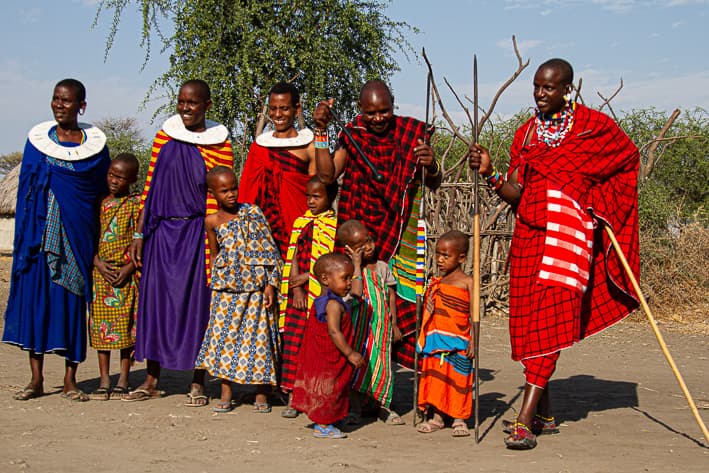
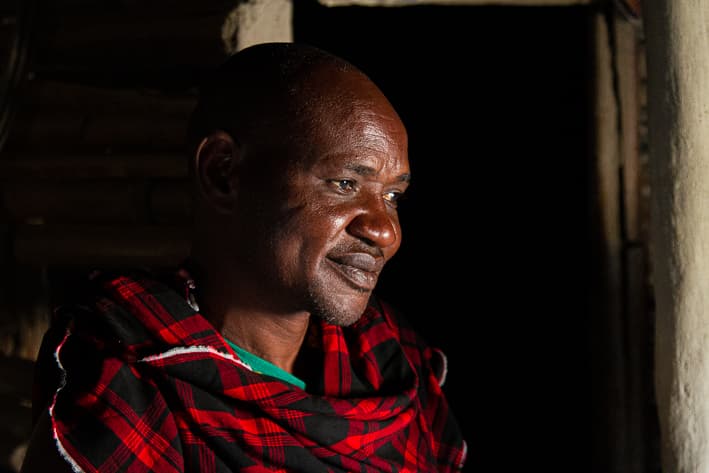
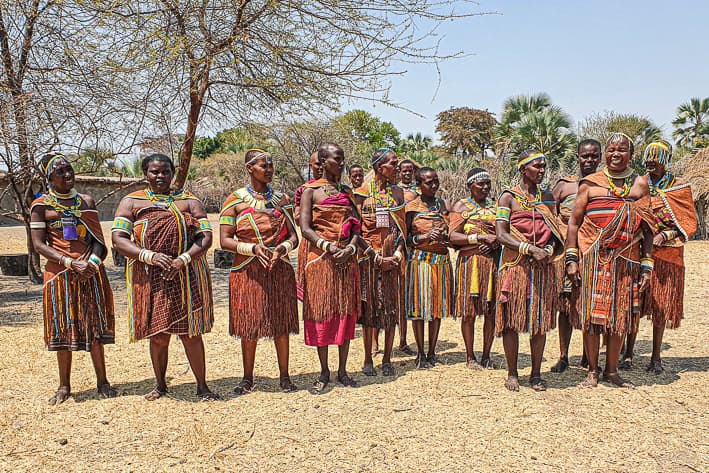
Mwiba’s helicopter safaris, our favorite way to explore Africa….
Mwiba Wildlife Reserve is a private concession in the south of the Serengeti and bordering the Ngorongoro Conservation area. We were collected from the airstrip by our guide and driven to the lodge in time for lunch. Mwiba Lodge is built around large granite rocks overlooking a perennial river and spring that attracts herds of buffalo and other animals and from all the tents and the main area you have views out over the river. The tents are spread out around the koppie giving guests plenty of privacy. Mwiba is a luxury lodge offering guests the opportunity to enjoy game drives, walking safaris, helicopter safaris and the privilege to forage with the Hadzabe tribe. Our first afternoon we went on a drive on the reserve and were lucky to see buffalo, elephant, giraffe and bat eared foxes. The following morning, we decided to start our walking safari experience that we had all come here for and so went on a long walk with our guide. This would be the intro to our Tanzania walking safari. After lunch back at the lodge we were driven a short distance to the helicopter pad where our Airbus helicopter was waiting to take us for a helicopter safari over the concession. We decided to keep the doors open for the ultimate helicopter experience. We took off and flew north exploring the remote areas of the concession seeing buffalo, giraffe, ostrich and impala along the way. Our pilot found a suitable landing spot on top of some rocks for our drinks stop. This is the beauty about a helicopter safari, you can explore remote areas of Africa, landing in places where vehicles cannot reach for the ultimate in drinks or lunch spots!
After enjoying our drinks and snacks in one of the remotest parts of the concession, we took off and flew south to the Great Rift Escarpment overlooking Lake Eyasi. We did some extremely low flying along the river until the ground just dropped away below us forming waterfalls, gorges and river pools. It felt like an Airwolf episode as we flew through the gorge finding a spot to land for a swim in the river. Looking around at the towering cliffs of the gorge, we knew that this was the only way anyone could get down here for a swim in the river, we felt extremely privileged to be able to experience this sort of safari. As it was starting to get dark, our pilot hurried us as we had to get to our sleeping spot before it got too dark. A short flight away, we landed in the middle of nowhere, and after the dust had settled we were rewarded with a view of our fly-camp for the night. Setup overlooking a dry riverbed and freshwater spring was a simple, yet comfortable fly-camp and campfire. We were greeted by our smiling team from the lodge. We settled down around the fire with our G&T and chatted about the incredible day we had. How could we top this day of walking safaris and helicopter safaris rolled into one incredible experience.
Our fly-camp consisted of tents of mosquito nets with proper comfortable beds and there was a traditional bucket-shower and camp toilet – this was all that we needed sleeping under the stars in the wilds of Tanzania. Falling asleep listening to hyenas calling in the distance is all part of the sleep-out experience.
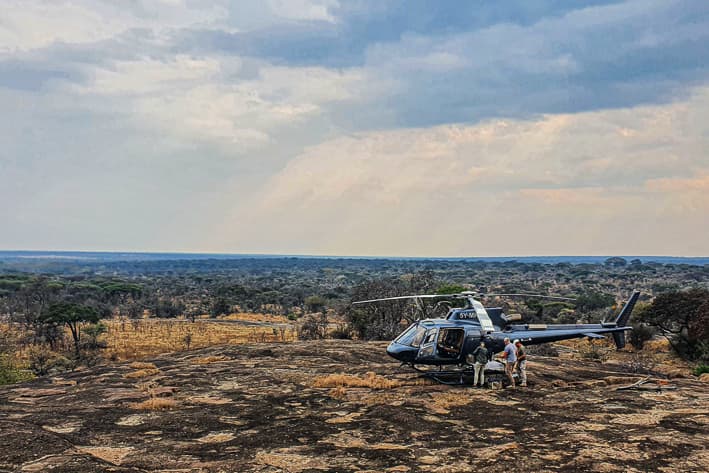
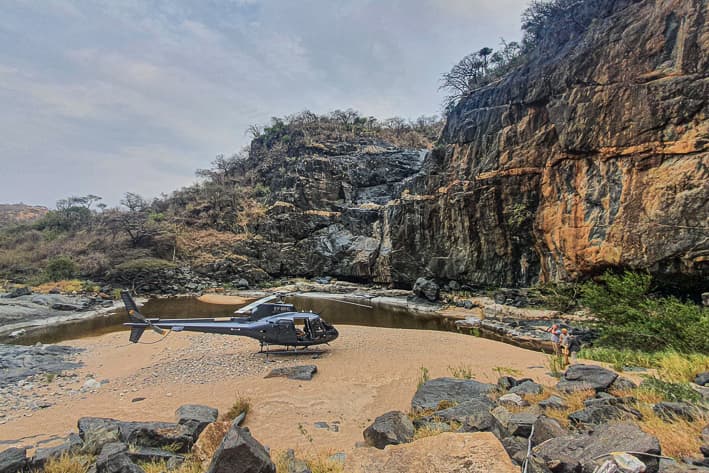
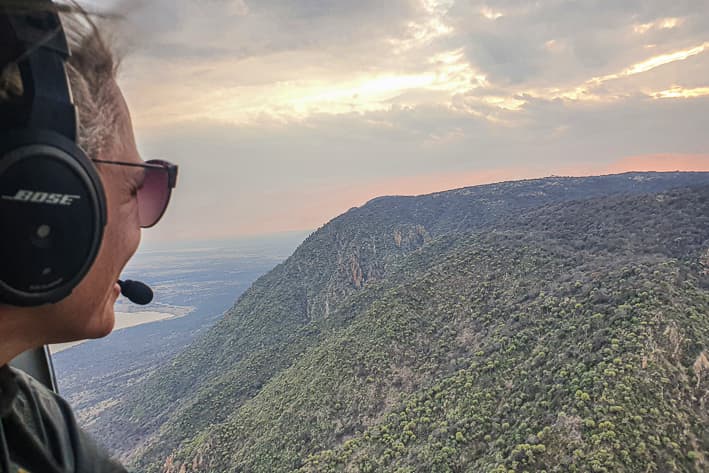
Foraging with the Hadzabe Tribe….
The following morning after breakfast around the fire we set off on our walking safari to meet up with the Hadzabe tribe that live on the concession and are allowed to hunt small animals as their way of life. We met the tribe and followed them as they moved through the bush foraging for honey, nuts and small animals to hunt. The Hadzabe communicate by whistling as they spread out through the bush and not long into our walk with them, one of the tribe members found a beehive in a tree. After a short whistle the rest of the tribe quickly made their way over to help extract the honey. This hive was from stingless bees and the honey is very sweet. After our injection of energy from the honey we continued on our way until we heard more whistles coming from several of the tribe. They had cornered several dassies in a tree hollow. After a few minutes of chopping, three of the men managed to kill 6 dassies which is a great success for the tribe. A fire was started and the dassies were quickly cooked on the open flames so everyone in the tribe could have some meat to eat. One thing about the Hadzabe is they never sit still for long. No sooner had they cooked and eaten the meat of the dassies and they were off again in search of their next meal. Once we had finally caught up with them, they were beneath a large baobab tree. From the excitement on their faces, we could tell they had found something good here. While one of the men made pegs for the tree, another started a fire with sticks and before we knew it, one of the men was half-way up the tree, having knocked the pegs into the tree and used it to climb up. A second man climbed up with a burning branch to use the smoke to subdue the bees and allow him a small window to extract fresh honey. One of the amazing things about this whole experience was how happy they seemed. They were constantly joking with each other and laughing at their own jokes, but at the same time they were very conscious that we were there and were always looking out for us and making sure we were able to try the meat, honey and nuts they found. Overall, this was one of the most authentic, real cultural experiences where we had the privilege to go along with them on one of their daily hunts. Again, this was not a show for tourists, but was the real deal!
We returned to Mwiba Lodge for a quick shower and freshen up before heading out on the rest of our walking safari. We drove a short distance before getting out on foot for a good 4-hour walk into our next camp. We followed a drainage line and tracked a herd of buffalo who got wind of us and fled in the opposite direction. As with all walking safaris, it is more about the smaller elements of the African bush, as opposed to seeing large game. We walked into camp to met by smiling faces and fresh drinks. The camp was simple dome tents with proper mattresses on the floor and a bucket shower and camp toilet. That evening after a delicious dinner we laughed and reminisced about the incredible experiences we had enjoyed over the last few days. We had done so much in such a short space of time, it was tricky to pick out a highlight. From walking safaris, helicopter safaris, cultural experiences, game drives, big game, lions in trees, exceptional guiding, food and service, we had done it all. The first part of our Tanzania Safari was coming to an end.
The following morning after a short walk and helicopter transfer back to the lodge, we all went our separate ways. Some were returning home, while I continued my Tanzania safari to the Ngorongoro Crater and northern Serengeti……
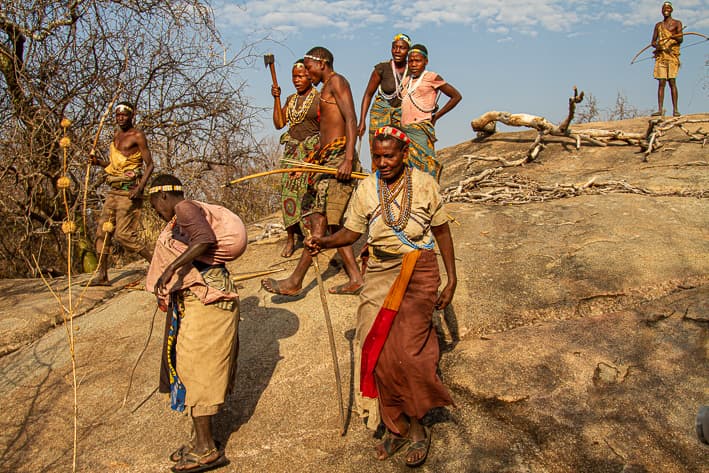
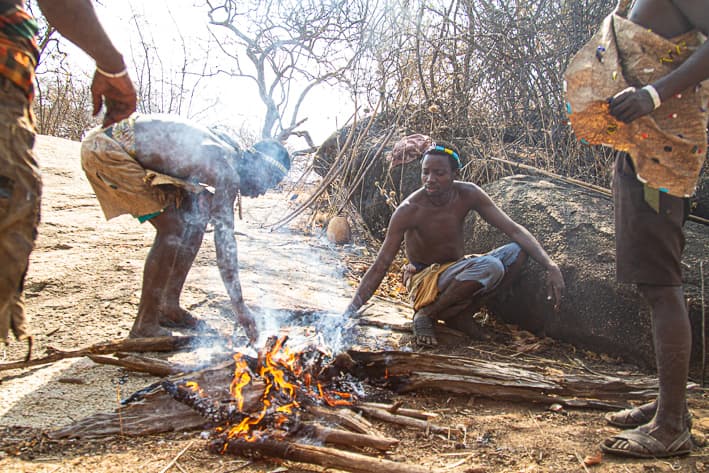
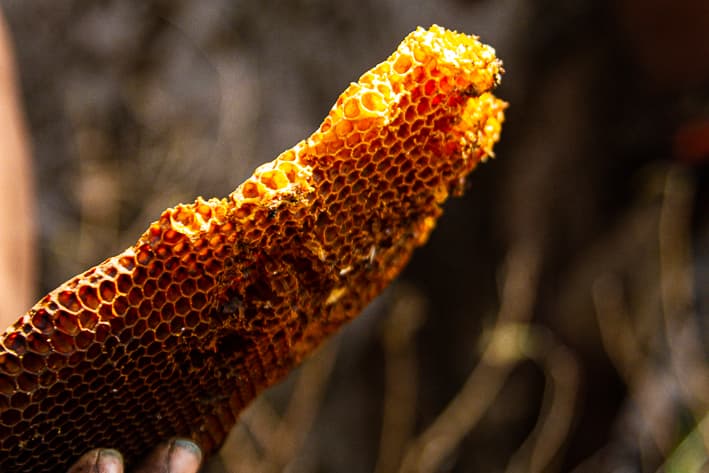
The Ngorongoro Crater Safari….
From Manyara Airstrip it was a 45-minute drive to the main gate of the Ngorongoro Crater and further 20 minutes to the viewpoint overlooking the Ngorongoro Crater. This has to be one of the most impressive views in Africa. I was staying at Nomad Tanzania’s Entamanu Ngorongoro Camp, located on the edge of the Ngorongoro Crater with incredible views across the caldera. That afternoon after settling in, we went on a Ngorongoro Crater rim walk with our Maasai guide. The walk takes through some forested areas, grasslands and finally out to the rim of the Ngorongoro Crater offering incredible views. After some photos, we walked back up the ridge through acacia woodlands to a surprise drink stop looking west towards the vast grassy plains of the Serengeti National Park.
The following morning, we had an early start to get to the descent road before sunrise. The drive to the crater descent road takes about 1-hour, although they are almost finished building a road that will be about 30-minutes away. As you get to the bottom you drive through a fever tree forest which is one of the best places to see leopard and black rhino. We were lucky enough to spot a black rhino feeding amongst the fever trees. A few meters on our guide spotted a pride of lions in the distance with some buffalo behind them. Within 10 minutes of being on the Crater floor, we had already seen 3 of the Big 5. Over the course of the day, we would end up seeing at least 30 different lions, 2 servals, some large elephant bulls with impressive tusks, herds of buffalo, herds of zebra and wildebeest, flamingos and so much more. This was a very productive day inside the Ngorongoro Crater, and it really lived up to expectations.
It is worth noting a few things about a visit to the Ngorongoro Crater. The location is in the highlands and so it gets quite cold in the mornings and evenings, so make sure to pack warm clothes. Most mornings are misty and cold and so vehicles are closed. The Ngorongoro Crater can get busy with vehicles, especially during peak seasons, and with limited road networks sightings can be crowded, especially if the animals are close to the road. On that note, vehicles are not allowed to drive off-road and so if animals are in the distance, you need a good pair of binoculars to see them. Because of this, we always try and send our guests to the Ngorongoro Crater at the start of their safari, but this is not always possible and is subject to the exact tailor-made safari we design.
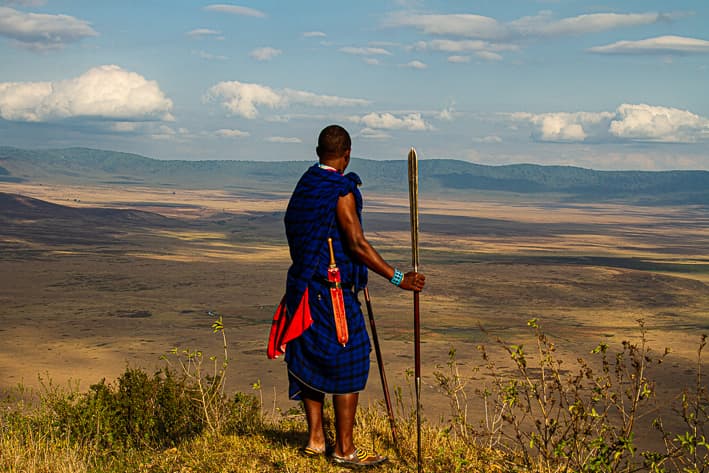
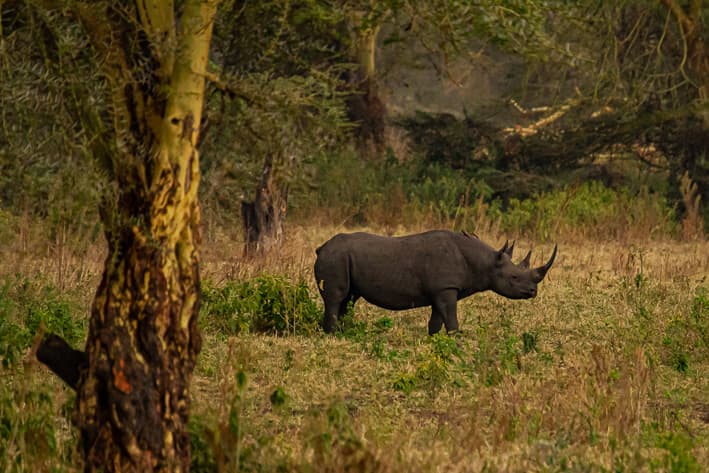
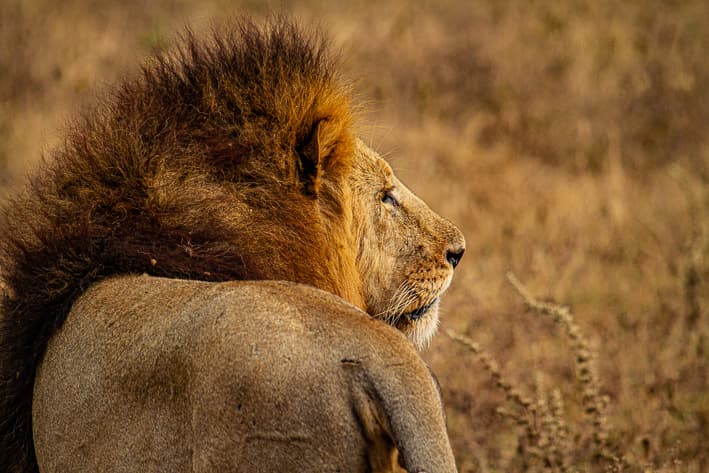
The Serengeti and the great migration…..
From the Ngorongoro Crater I flew north to the Kogatende Airstrip in the very north of the Serengeti National Park. At this time of the year, this is the best location to see the migration. From about July, the great migration starts to reach the Kogatende area where the Mara River creates a natural barrier for the herds. As we were flying into Kogatende, we could see the vast herds below us on the open grassy plains all walking in a line towards the north. Over the course of the next few months the migration moves between the Kogatende Area, Lamai wedge and the Maasai Mara in Kenya, but because the herds are so vast, there are always wildebeest in the Serengeti National Park, making this the best place to be. The migration follows the rains and most evenings it rained in the Serengeti which meant the herds remained in this area and moved between the Lamai wedge and the Kogatende section crossing the Mara River in the process. This meant some exciting Mara River Crossings over the course of several weeks. For more information on the Great Migration, please read about it on our “Serengeti Migration” page.
My first night was at Serengeti Safari Camp. This is an authentic mobile camp that moves throughout the Serengeti following the great migration, making it an ideal camp to have the best chance of seeing the migration. The camp consists of large Meru tents with proper, comfortable beds and an ensuite bathroom with running basins, traditional bucket shower and a camp toilet. There is a main area with lounge and dining area and a campfire where guests can sit around and chat about their days on safari in Tanzania. I was lucky enough to get my vehicle and guide and so I could focus the activities on my interests. The first afternoon drive we went in search of a female leopard who had 2 young cubs hiding in a rocky outcrop not far from the camp. There were already other vehicles there and so it wasn’t long before we saw her resting between the rocks. Her cubs were still well hidden, although we got a glimpse of one cub as it moved to a new hiding spot. The mother leopard was so well hidden that wildebeest and zebra started to move quite close to her spot and were grazing not far away at all. Even though she had killed a young wildebeest the day before, leopards are opportunistic hunters and so she quickly moved into hunt mode and crept into an area to launch her attack. The next thing zebra and wildebeest burst out from running in all directions as she launched, but on this occasion she was unsuccessful. This was a great start to my safari to the Serengeti.
The next morning, our focus turned to river crossings and so we spent the morning driving the length of the Mara River looking for herds that would be moving down to the different crossing points. After a couple of hours, we saw a large herd moving at speed from the Lamai Wedge towards the river, so we followed them hoping they would cross. Once they got to the river, they hesitated, walked between crossing points, until finally at around 13.30 (we left camp at 06.00) the first brave wildebeest made the leap into the crocodile infested Mara River. This is when herd mentality kicks in and with the first one making the move, the rest of the herd follows. We had a prime spot watching as thousands of wildebeest jumped into the river and swam towards us. What an incredible sight to see as they made their way across the river and out the other side. On this occasion there were no crocodiles and so all (except 1) made it safely across. WOW, what an amazing first day in the Serengeti.
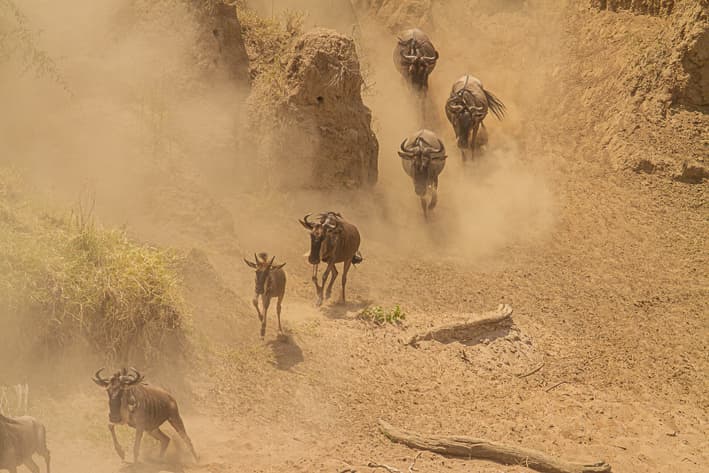
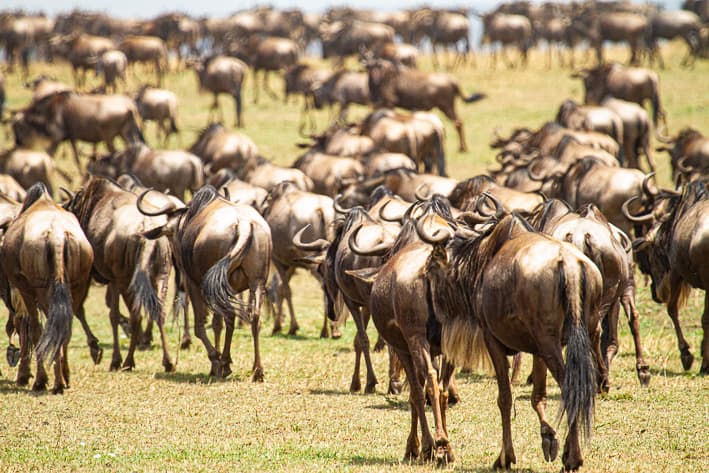
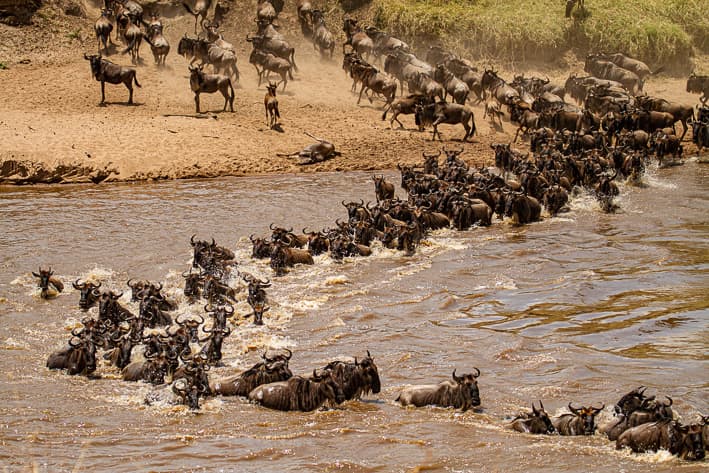
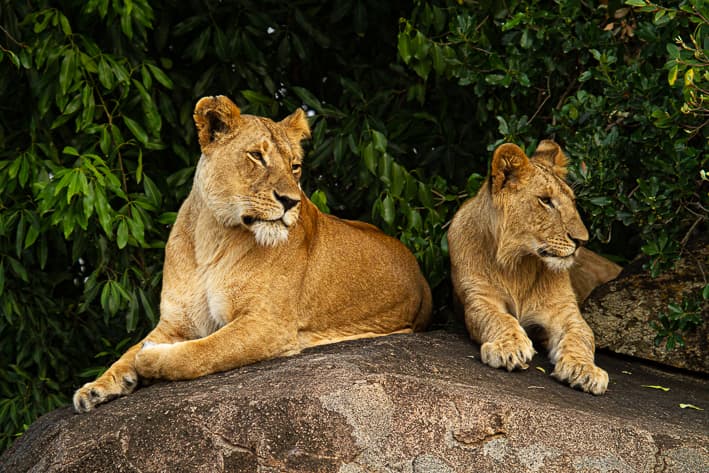
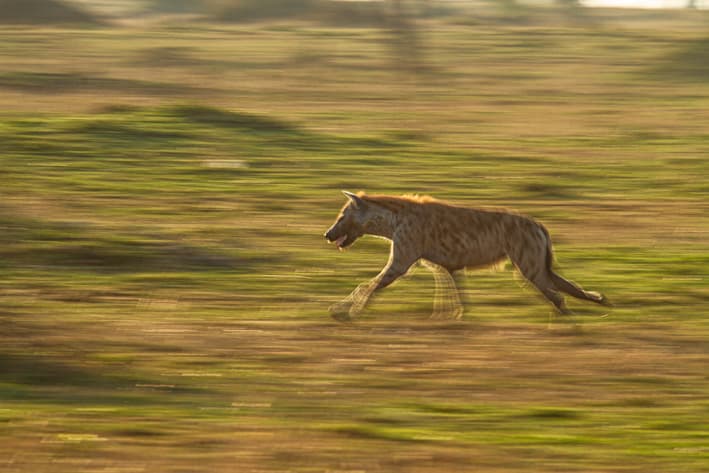
River crossings…..
After the excitement of the first morning safari, I needed something a little more relaxing for the afternoon, so after transferring to the nearby Lamai Serengeti Lodge, I decided to enjoy a walking safari through the Serengeti. We set off from the lodge in the afternoon and walked through the grasslands between the migration. We followed a small river as we could see vultures settling nearby. Amongst the bushes was a dead wildebeest that the vultures were feeding on. We had also scared a hyena who quickly ran off. By now, you know we love walking safaris and having the privilege of being able to walk in the Serengeti amongst the great migration is an incredible experience. As the sun was setting, we rounded a rocky outcrop and there, waiting for us was a drinks stop all setup and ready with G&Ts, cold beers and the perfect African sunset. Another amazing day on safari in Tanzania.
Lamai Serengeti is a permanent camp situated on a prominent rocky outcrop (known locally as a koppie) with incredible views of the grassy plains of the northern Serengeti. The rooms are well spaced around the koppie, all with expansive views from the bed and the room. There is a small pool area as well as a private section with a couple of rooms and its own main area, perfect for a family to use on an exclusive use basis. Your own private piece of Africa for the ultimate in exclusive family safaris. Even when the migration is not in the area, the Kogatende and Lamai regions of the Serengeti are still very productive with excellent resident game. We often suggest combining Lamai with another area of the Serengeti to get a full Serengeti Safari experience.
The following morning, we headed on another game drive to see what we could find out there in the Serengeti and our morning could not have started any better. We had stopped to watch a herd of wildebeest move through a small riverine gulley when they all of a sudden panicked and scattered. We knew there was a predator lurking in the bushes and so went in closer for a look and there slinking in the bushes was a leopard trying its luck as the wildebeest crossed the gulley. She soon disappeared to try her luck somewhere else, so we continued our drive and not long after that we came across a lioness and 2 cubs playing up on a rock. After about 5-minutes of watching these 3 lions, my guide looked across and saw another lioness walking towards us carrying what must have been a week-old cub in her mouth. She was moving her young cubs from one rocky outcrop to another, and we were to see that. After she had moved her cub to a new den-site, we moved off and soon found a large male watching over the plains of the Serengeti.
We continued along the Mara River looking for potential herds looking to cross, but unfortunately at that stage all the herds were either already on this side of the river or were far away from it, so we had a bush breakfast before it was time for me to change camps again. I met my new guide at the Kogatende Airstrip, and we set off for the rest of the day in search of the herds looking to cross. We soon found some promising signs as the herds were moving along the river looking for a suitable crossing site. We had moved off to give the wildebeest some space and not long after that, the first animals started to move down to the river and start crossing. We found our spot and watched for the next 45-minutes as more and more wildebeest, zebra and topi made their way down to the river and crossed. This time, they had chosen a rocky area of the river with rapids, faster flowing water and wet, slippery rocks which made the crossing a little more difficult and dangerous. Added to this, there was a large crocodile that took a baby wildebeest as it swam across a little further away from the safety of the herd. As more and more animals tried to cross, the rocks became even more slippery making it more difficult for them to get across. Animals were slipping everywhere, getting caught in the flowing water and being washed downstream. We watched as a mother zebra and her baby tried to cross, but the baby was not strong enough and soon got caught in the flow and was being washed down through the rapids. The mother swam back and pushed her baby back towards the bank and safety. After catching its breathe they moved back to the bank, but further away from the current and rapids and started swimming again, but this time towards a large crocodile. The mother must have a lot of experience as she quickly steered her baby away from the crocodile and safely around the rest of the obstacles until, they finally reached the other side.
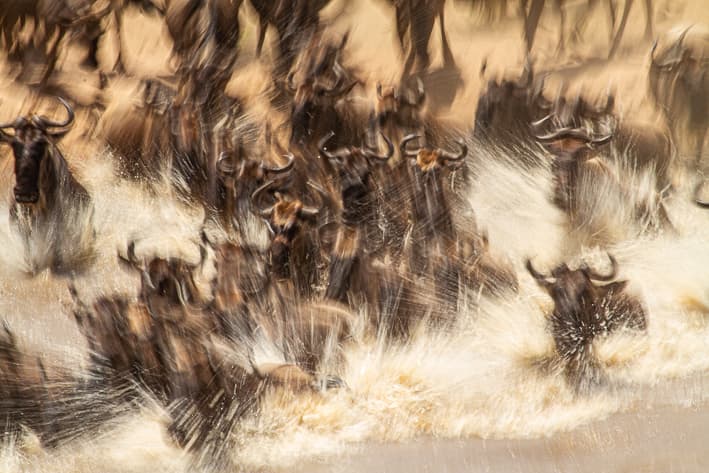
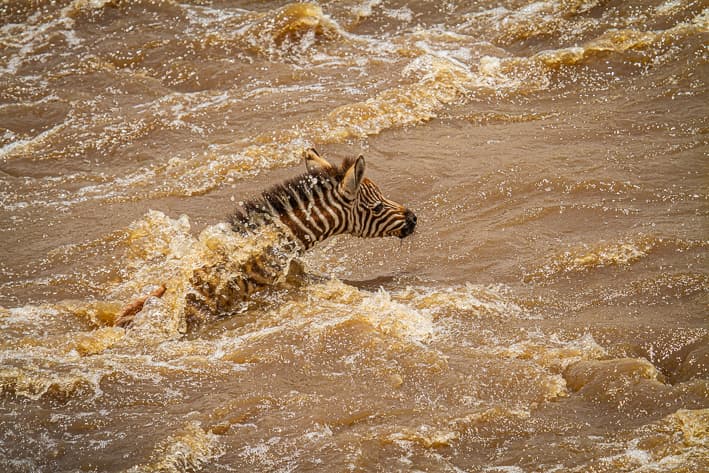
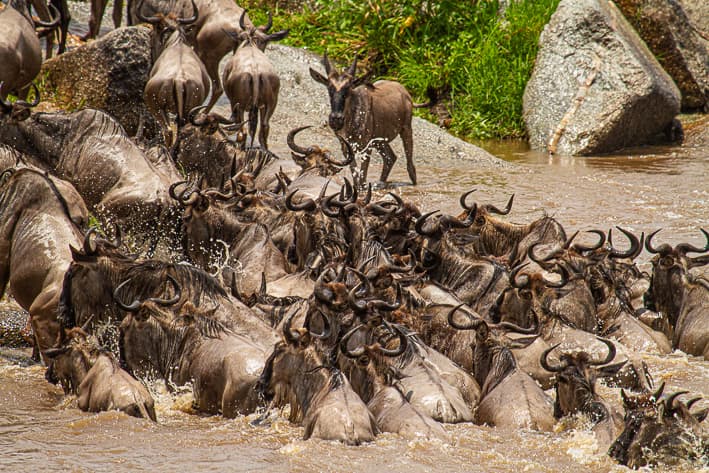
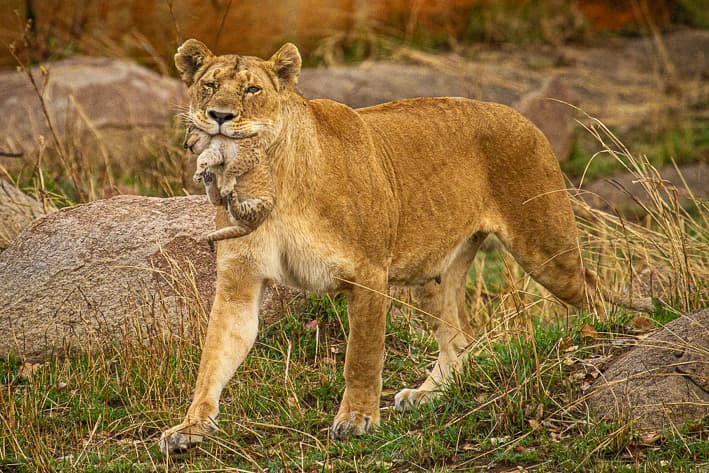
Tanzania delivers again….
After about 45-minutes for some reason the herds stopped crossing and remained on our side of the river and as things at the river calmed down, the reality of nature was present. Caught in the rapids, with barely its face out the water was an adult wildebeest fighting for its life. Unfortunately, its leg was caught in-between rocks and there was no way it would get free. Then on the rocky island in the middle of the river was another youngster that had also got its leg caught between rocks. It was exhausted and could not free its leg. In total at that one crossing at least 3 wildebeest had died. Others had been washed down stream and so we are not sure if they made it or not. This is unfortunately the reality of the great migration with only about 30% of the wildebeest born in February that make it back to the grassy plains in the south of the Serengeti a year later.
After the crossing had finished, we continued our drive following the herds moving along the river. Further down the river the herds were crossing a shallow riverbed and yet again there was a leopard waiting for its opportunity which it took, taking down a young wildebeest and dragging it under some bushes. Yet another incredible day on safari in the Serengeti amongst the great migration. We headed to my new camp for the night. I would be staying at Songa Migrational Camp which is also a “mobile” camp that moves between the southern plains of the Serengeti when the migration is there (December to March) and then relocates to the Kogatende area from June to the end of October when the herds of up in that area. What an amazing camp with several guest areas including a lounge, library and dining tent. All the guest tents are spread out overlooking the grassy plains of the Serengeti. The tents are very spacious and have an ensuite bathroom complete with flush toilet and one of the most powerful showers I have ever had. It is amazing what they have achieved in a “mobile” camp with hot and cold running water. Every guest/group staying at the camp gets their own vehicle and guide, allowing guests to focus their safaris on their interests. The guides are some of the best in Tanzania and make an effort to avoid the crowds at sightings which I really appreciated and enjoyed.
My safari in Tanzania had come to an end and it was time to head home. This has to rate as one of my all-time favorite trips. It had everything you could want from an African Safari. We had authentic cultural experiences with Maasai, Barbaig tribe and Hadzabe, we had incredible bush dinners, breakfasts and lunches, walking safaris, helicopter safaris, incredible wildlife, the Great Migration including river crossings and then on top of that we stayed in some of Tanzania’s best safari camps and lodges and had some of the best guides in the business. It was very encouraging to see the number of international guests that were travelling and enjoying the same experiences I had. This is definitely the time to travel and to take advantage of fewer vehicles at sightings and fewer people at the camps. This often means most guests will get their own vehicles for game drives.
If you want to experience what I did, please let me know and I will gladly help you plan this incredible safari to Tanzania. Get in touch now and start planning your own Safari to Tanzania.

